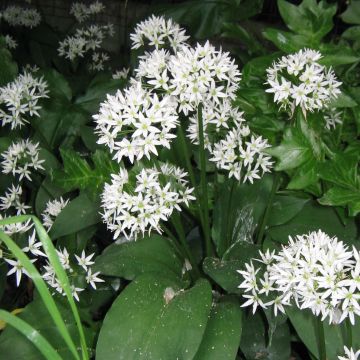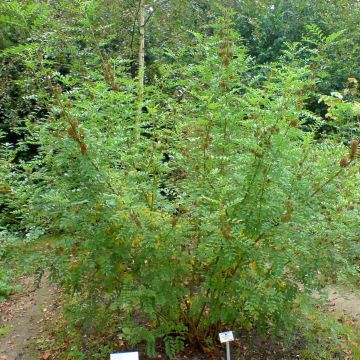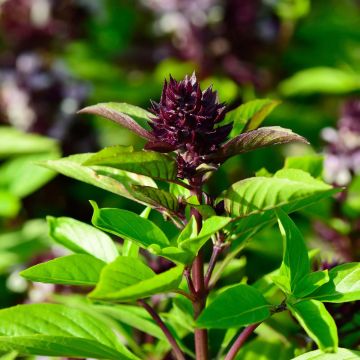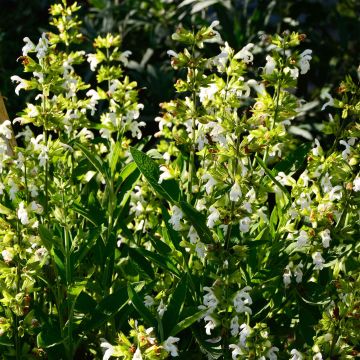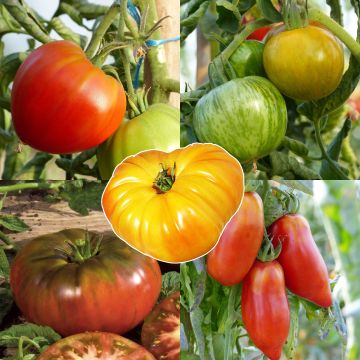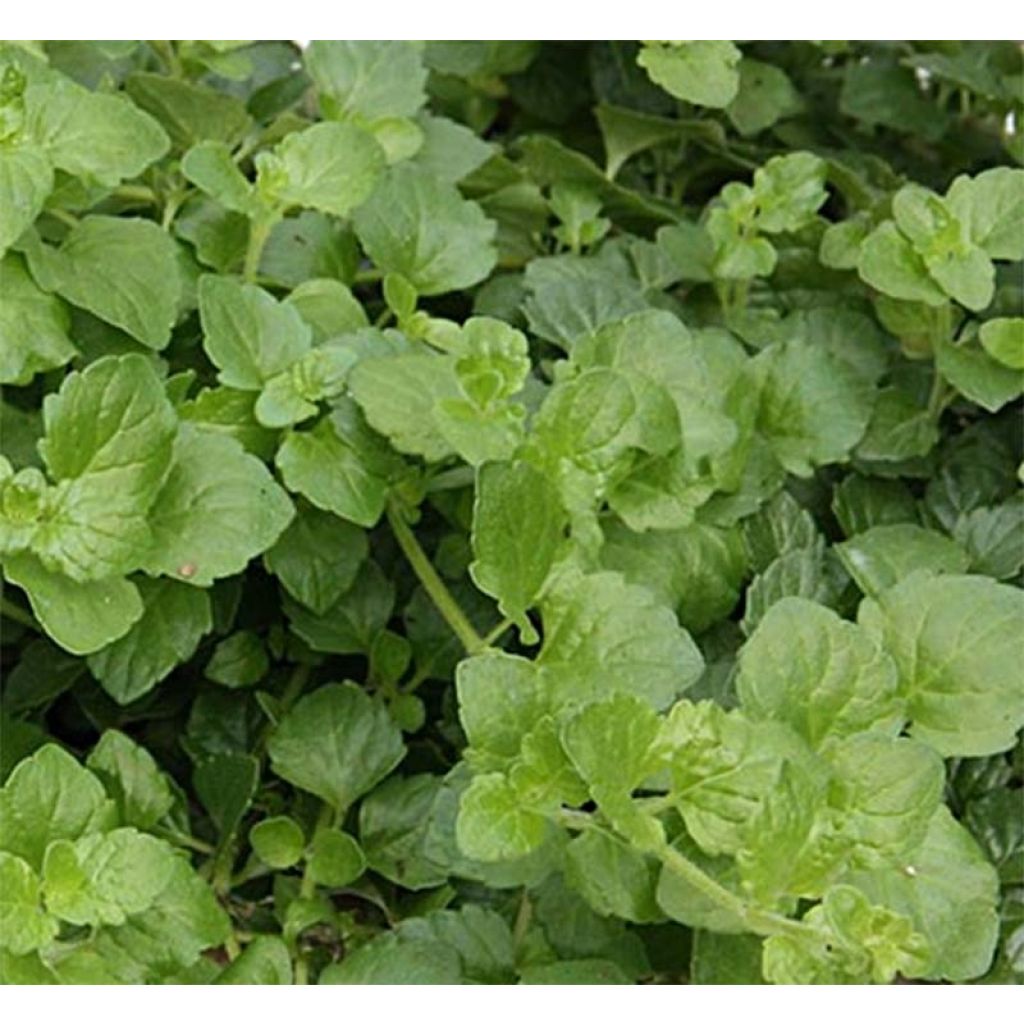

Satureja douglasii Indian Mint
Satureja douglasii Indian Mint
Satureja douglasii Indian Mint
Yerba Buena
Why not try an alternative variety in stock?
View all →This plant carries a 6 months recovery warranty
More information
We guarantee the quality of our plants for a full growing cycle, and will replace at our expense any plant that fails to recover under normal climatic and planting conditions.
From €5.90 for pickup delivery and €6.90 for home delivery
Express home delivery from €8.90.
Does this plant fit my garden?
Set up your Plantfit profile →
Description
Satureja douglasii Indian Mint is neither a mint nor Indian. It is actually an astonishing Mexican savory plant that is particularly aromatic, spreading as ground cover or draping down in long curtains when grown at a height. It is appreciated both in hanging baskets and in the vegetable garden, and is used in infusions and enhances the flavour of salads and cocktails with its pleasant peppermint aroma. In summer, bees love its tiny white flowers. This tender perennial can only be grown in open ground in regions that are not affected by frost. Everywhere else, it is grown as an annual or in pots to be protected from frost.
Satureja douglasii (also known as Clinopodium douglasii), also called Douglas Savory, is a perennial plant in the mint family, closely related to mint and thyme. This 'yerba buena' of Spanish settlers is native to the west coast of the United States (California) and Mexico. In the wild, it grows in dry areas with low annual precipitation but almost no winter frost.
Indian Mint develops long, slender, and flexible stems up to 2m (7ft) long in a single season. When these stems come into contact with the ground, they root in place. They bear small round leaves, 2cm (1in) long, light green, strongly veined, with toothed edges, and exuding a powerful menthol aroma. The foliage persists all year round above freezing temperatures. Flowering occurs in summer, from June to August. Along the stems, at the axils of the leaves, small white or slightly lilac-pink flowers with two lips appear, which are very attractive to bees and rich in nectar. The city of San Francisco was once called Yerba Buena, named after this beautiful savory plant that was abundant there. Its hardiness does not exceed -5°C (23°F), for a short period of time and in dry soil.
Easy to grow but frost-sensitive, Indian Mint is a plant that is both beautiful and useful and makes a great impression in hanging baskets. It will also find its place in the vegetable garden as well as in a rockery in the ornamental garden or in a container on the terrace or balcony. It will create a stunning cascading effect when planted in simple bags filled with potting soil and hung on a wall. The leaves can be harvested as needed, with fresh leaves being much more aromatic. Its only requirements in pots are a warm and sunny exposure and slightly moist soil. It has rapid growth and can be used as ground cover in sunny flower beds as an annual; in open ground, this savory plant is drought resistant. It can be paired with e.g. rosemary, thyme, Dichondra repens, Muehlenbeckia complexa.
Please note that our young plug plants are professional products intended for experienced gardeners: upon receipt, transplant them and store them under cover (veranda, greenhouse, cold frame etc.) at a temperature above 14°C (57.2°F) for a few weeks before planting them outdoors once the risk of frost has passed.
Report an error about the product description
Flowering
Foliage
Plant habit
Botanical data
Satureja
douglasii
Indian Mint
Lamiaceae
Yerba Buena
North America
Other Herbs A to Z
Planting and care
Plant Indian mint only in areas spared from frost. Place it in full sun or partial shade in any well-drained soil, even if it is rocky, alkaline, poor, or dry in summer. Its hardiness does not exceed -5°C (23°F), for a short period and in dry soil. Everywhere else, it can be cultivated in a pot.
Prepare a rich and well-drained mixture composed of compost, ordinary soil, and sand. Choose a sheltered and sunny location. Water regularly but not excessively, allowing the soil to dry a little between waterings. Regular fertilisation with flowering plant fertiliser will promote spectacular growth. Before the arrival of frost, prune your Indian mint and shelter it in a very bright, well-ventilated place, but kept frost-free. Watering should be reduced until spring when vegetation resumes.
Planting period
Intended location
Care
-
, onOrder confirmed
Reply from on Promesse de fleurs
Herbs
Haven't found what you were looking for?
Hardiness is the lowest winter temperature a plant can endure without suffering serious damage or even dying. However, hardiness is affected by location (a sheltered area, such as a patio), protection (winter cover) and soil type (hardiness is improved by well-drained soil).

Photo Sharing Terms & Conditions
In order to encourage gardeners to interact and share their experiences, Promesse de fleurs offers various media enabling content to be uploaded onto its Site - in particular via the ‘Photo sharing’ module.
The User agrees to refrain from:
- Posting any content that is illegal, prejudicial, insulting, racist, inciteful to hatred, revisionist, contrary to public decency, that infringes on privacy or on the privacy rights of third parties, in particular the publicity rights of persons and goods, intellectual property rights, or the right to privacy.
- Submitting content on behalf of a third party;
- Impersonate the identity of a third party and/or publish any personal information about a third party;
In general, the User undertakes to refrain from any unethical behaviour.
All Content (in particular text, comments, files, images, photos, videos, creative works, etc.), which may be subject to property or intellectual property rights, image or other private rights, shall remain the property of the User, subject to the limited rights granted by the terms of the licence granted by Promesse de fleurs as stated below. Users are at liberty to publish or not to publish such Content on the Site, notably via the ‘Photo Sharing’ facility, and accept that this Content shall be made public and freely accessible, notably on the Internet.
Users further acknowledge, undertake to have ,and guarantee that they hold all necessary rights and permissions to publish such material on the Site, in particular with regard to the legislation in force pertaining to any privacy, property, intellectual property, image, or contractual rights, or rights of any other nature. By publishing such Content on the Site, Users acknowledge accepting full liability as publishers of the Content within the meaning of the law, and grant Promesse de fleurs, free of charge, an inclusive, worldwide licence for the said Content for the entire duration of its publication, including all reproduction, representation, up/downloading, displaying, performing, transmission, and storage rights.
Users also grant permission for their name to be linked to the Content and accept that this link may not always be made available.
By engaging in posting material, Users consent to their Content becoming automatically accessible on the Internet, in particular on other sites and/or blogs and/or web pages of the Promesse de fleurs site, including in particular social pages and the Promesse de fleurs catalogue.
Users may secure the removal of entrusted content free of charge by issuing a simple request via our contact form.
The flowering period indicated on our website applies to countries and regions located in USDA zone 8 (France, the United Kingdom, Ireland, the Netherlands, etc.)
It will vary according to where you live:
- In zones 9 to 10 (Italy, Spain, Greece, etc.), flowering will occur about 2 to 4 weeks earlier.
- In zones 6 to 7 (Germany, Poland, Slovenia, and lower mountainous regions), flowering will be delayed by 2 to 3 weeks.
- In zone 5 (Central Europe, Scandinavia), blooming will be delayed by 3 to 5 weeks.
In temperate climates, pruning of spring-flowering shrubs (forsythia, spireas, etc.) should be done just after flowering.
Pruning of summer-flowering shrubs (Indian Lilac, Perovskia, etc.) can be done in winter or spring.
In cold regions as well as with frost-sensitive plants, avoid pruning too early when severe frosts may still occur.
The planting period indicated on our website applies to countries and regions located in USDA zone 8 (France, United Kingdom, Ireland, Netherlands).
It will vary according to where you live:
- In Mediterranean zones (Marseille, Madrid, Milan, etc.), autumn and winter are the best planting periods.
- In continental zones (Strasbourg, Munich, Vienna, etc.), delay planting by 2 to 3 weeks in spring and bring it forward by 2 to 4 weeks in autumn.
- In mountainous regions (the Alps, Pyrenees, Carpathians, etc.), it is best to plant in late spring (May-June) or late summer (August-September).
The harvesting period indicated on our website applies to countries and regions in USDA zone 8 (France, England, Ireland, the Netherlands).
In colder areas (Scandinavia, Poland, Austria...) fruit and vegetable harvests are likely to be delayed by 3-4 weeks.
In warmer areas (Italy, Spain, Greece, etc.), harvesting will probably take place earlier, depending on weather conditions.
The sowing periods indicated on our website apply to countries and regions within USDA Zone 8 (France, UK, Ireland, Netherlands).
In colder areas (Scandinavia, Poland, Austria...), delay any outdoor sowing by 3-4 weeks, or sow under glass.
In warmer climes (Italy, Spain, Greece, etc.), bring outdoor sowing forward by a few weeks.











































